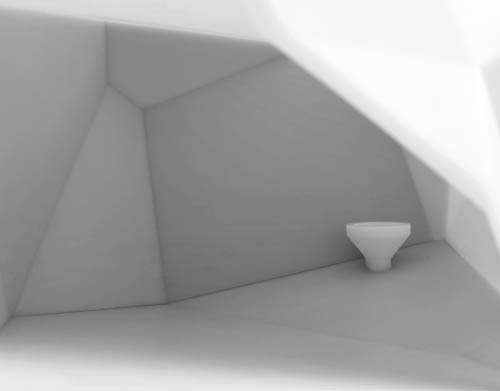The Extra Room is a project by Bernhard Hopfengärtner and TheGreenEyl; it went on display last year as part of the What If... show at the Science Gallery in Dublin. [Image: From The Extra Room by Bernhard Hopfengärtner and TheGreenEyl].
[Image: From The Extra Room by Bernhard Hopfengärtner and TheGreenEyl].
The Extra Room proposed a secret space "built into the basement of a multi storey building where it is shared by the house’s inhabitants," and inside of which those inhabitants could spend time alone and practice "protective self discipline."
"Utilising effects of sensory deprivation and methods used by the military to break someone down," the artists explain, "the room enables subjects to adjust their thinking and beliefs." It is a sensory-deprivation chamber by another name, in other words, a "reversed disciplinary architecture" in which you can lose yourself in the facets of a silent, white geometry and temporarily go a bit nuts. Think of it as a room for Socratic self-interrogation in an era of waterboarding and Guantanamo Bay.
While the actual image, seen above, is by no means the most interesting illustration that could have been produced for this project, the basic idea behind it—that architects, sociologists, and even behavioral psychologists could someday team up to explore a new architecture with deliberately cultivated neurological side-effects—suggests a moral risk to the design of private space that deserves further exploration. In fact, the idea that we could build a kind of psychological sacrifice zone in the basement of a residential high-rise is a narratively compelling one. Perhaps an entire district of the city could be architecturally adapted for the needs of self-experimentation, testing your own limits in the face of strange ornament and topologically inconsistent space. You receive a prescription for a five-hour visit to the Extra Borough, and you walk in, alone, faced with odd, windowless buildings and empty squares on either side. It is an urban arena for a new breed of psychological X-Games.
Lưu trữ Blog
-
▼
2010
(3068)
-
▼
tháng 3
(221)
- I get distracted by some of the sights
- How termites get into your house
- Conditions Report - March 31, 2010
- New World Order
- Venturing to South County for a change
- Calosoma beetle
- Birthday girl
- Trend Alert - Double Denim
- Älskade Skatås
- HAMMOCK - BREATHTURN
- PHOTOART OF WHITE WHITE BROWN TWIG
- Events in the Landscape and their Acoustic Shadows
- Warsound
- The crazies are taking over!
- Expedition Sled Rigging
- MGMT - FLASH DELIRIUM VIDEO
- Week Ending March 28 (WS - 12 weeks)
- Hooga Hooga Hooga Chakka!
- UIAA Gear Testing Videos
- Quick Links 9
- Dagen efter 44:30
- I hear you Sister (Mary)!!
- Supermodel
- When a little says a lot.
- Antelope Island 50k
- Vad hände?
- April and May Climbing Events
- Inside Hoi
- Tofu Noodle Soup
- Playlist - 27th March 2010
- Table of Contents
- The Extra Room
- L.A. on the Nile
- Gissa tiden
- For want of an "a" the blog was lost
- Eraser drawing
- And the winners are:
- Zoo Welcomes 25 Baby Dragons
- Strawberry and Dark Chocolate Ice Cream Cone Cupcakes
- Vivarium
- Snake Bites - First Aid and Prevention
- Var ska jag börja?
- Hero's and Villains
- Whoopie Pies
- First Post for An American Cupcake in London!
- It's not our fault John
- Klip House
- Netflix via Wii - Coming Soon
- GLASS CANDY - FEELING WITHOUT TOUCHING
- DELOREAN - STAY CLOSE
- Wail of woe
- Urban Fossil Value
- Imagine a €10 lunch in Vienna!
- Pannkaksplatt
- CANDIE - ELEPHANT MAGAZINE
- Conditions Report - March 24, 2010
- TANLINES - SETTINGS EP
- What actually happened
- Dear Mr President
- Spare me from exploring cats
- YACHT - THE AFTERLIFE
- YUCK - "GEORGIA" + HERZOG - "PAUL BLART AND THE DE...
- PHOTOGRAPHY BY ANASTASIA CAZABON
- Sunburns in the Mountains
- Halsen hänger på..
- Just like living with Tony Barber..........
- Kylie and Mia (and a giveaway)
- Shanghai Seedling
- Yep - it's FUBAR
- Access Restricted
- Migratory Anagram
- GOLDFRAPP - HEAD FIRST
- MGMT - CONGRATULATIONS
- Döda ben - döda ben
- In Defense of Soloing
- Crock-a-doodle-dooooo!
- Judge Not- Part 2
- And the winner is:
- Week Ending March 21 (WS minus 13 weeks)
- March and April Climbing Events
- Borrego Bugs
- Playlist - 20th March 2010
- ctrl-alt-del
- Weekend Warrior - Videos to get you stoked!
- Heros, Villians and the week that was.
- California City Expedition Update!
- PHOTOGRAPHY OF JEFF LUKER
- HIGH PLACES - THE LONGEST SHADOWS
- Vertical Limit - An Instructional Video
- Regn, ösregn, ösregn plus blåst
- Please say hi to Mr Moo.
- Ultralöpning i Göteborg
- Two L.A. Evenings
- Spring has Sprung
- Climbing and Outdoor News from Here and Abroad - 3...
- Bad Boyz Bad Boyz - What you gunna do.
- Status
- Wet Pussy
- Toddler terror and a lovely giveaway
- Friends Update
-
▼
tháng 3
(221)